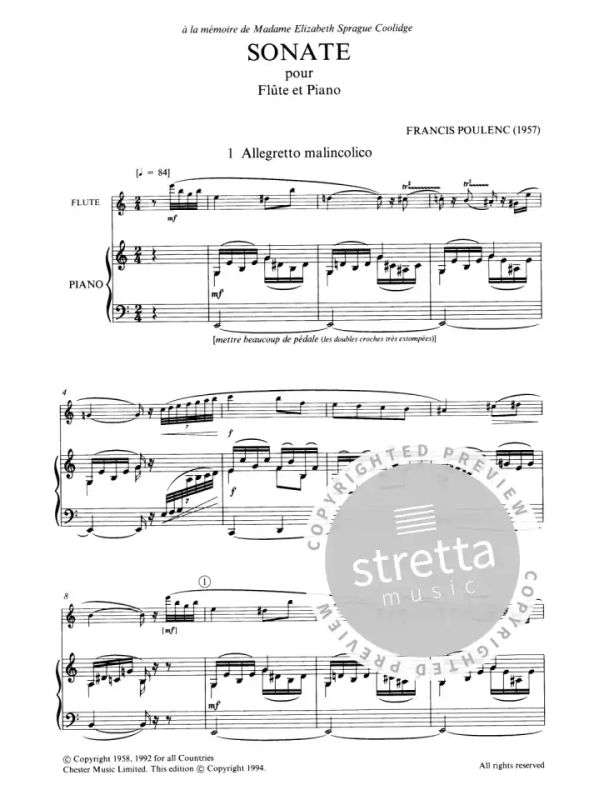- Francis Poulenc Clarinet Sonata Sheet Music
- Francis Poulenc Flute Sonata
- Francis Poulenc Clarinet Sonata
- Francis Poulenc Sonata For Flute And Piano
The clarinet sonata is one of three that Poulenc wrote for solo woodwind and piano, part of a planned set that he did not live to complete. A sonata for flute was composed in 1956, while one for oboe was completed a few weeks after the one for clarinet. Francis Poulenc composed his Flute Sonata in 1957 and it is now perhaps the most widely played of all flute sonatas. It encompasses a wide range of moods, from a 'melancholic' first movement to a hauntingly beautiful Cantilena, and a playful and energetic Presto to finish.
- Poulenc's Sonata of 1957 is dedicated to the memory of that champion of twentieth-century chamber music, Elizabeth Sprague Coolidge. The Sonata's own cause was promoted by the Chesterian magazine (Spring 1958) which declared: ‘For Francis Poulenc, a medium such as Flute and Piano is ideal for expressing himself in his inimitable style.
- Ortiz, Wagner: Sonata Francesa (Opus 44) Flute and Piano / Intermediate to difficult / 1 PDF / 1 MP3. Francis Poulenc: Sonata For Clarinet And Piano: Clarinet: Instrumental Work Clarinet and Piano Sheet music + Audio access Chester.
Francis Poulenc wrote his Sonate pour flûte et piano in 1957 in response to a commission from the Elizabeth Sprague Coolidge Foundation at the U.S. Library of Congress. The work is dedicated to the memory of Coolidge, one of the twentieth century's greatest champions of chamber music.

A sense of restless melancholy pervades the first movement (Allegretto malincolico) of Poulenc's Sonata. It opens with an expansive melody filled with delightfully unexpected twists and turns. Often, this music seems to glance back at the elegant lines of baroque and classical music. At the same time, it pays homage to a distinctly French clarity. While working on the Sonata, Pouenc wrote in a letter to his friend, Pierre Bernac,

In working on this Flute Sonata I have the feeling of going back a long way, but with a more settled technique. It's a sonata of Debussyan dimensions. It's the French sense of balance [la mesure française]. Finding the form for your language is the most difficult thing. It's what Webern has in the highest degree … and what Boulez has not yet found.
Francis Poulenc Clarinet Sonata Sheet Music
The second movement (Cantilena) is serene and songlike. It has been described as '‘a great rainbow of melody.' The final movement (Presto giocoso) is an exuberant romp filled with witty neoclassical caricatures. Listen for the moment when all of the frolicking forward motion halts in a brief pause, followed by a plaintive remembrance of a theme from the first movement.
Francis Poulenc Flute Sonata

Francis Poulenc Clarinet Sonata

A sense of restless melancholy pervades the first movement (Allegretto malincolico) of Poulenc's Sonata. It opens with an expansive melody filled with delightfully unexpected twists and turns. Often, this music seems to glance back at the elegant lines of baroque and classical music. At the same time, it pays homage to a distinctly French clarity. While working on the Sonata, Pouenc wrote in a letter to his friend, Pierre Bernac,
In working on this Flute Sonata I have the feeling of going back a long way, but with a more settled technique. It's a sonata of Debussyan dimensions. It's the French sense of balance [la mesure française]. Finding the form for your language is the most difficult thing. It's what Webern has in the highest degree … and what Boulez has not yet found.
Francis Poulenc Clarinet Sonata Sheet Music
The second movement (Cantilena) is serene and songlike. It has been described as '‘a great rainbow of melody.' The final movement (Presto giocoso) is an exuberant romp filled with witty neoclassical caricatures. Listen for the moment when all of the frolicking forward motion halts in a brief pause, followed by a plaintive remembrance of a theme from the first movement.
Francis Poulenc Flute Sonata
Francis Poulenc Clarinet Sonata
Francis Poulenc Sonata For Flute And Piano
Earlier this week the Frankfurt Radio Symphony released this performance, featuring their superstar principal flutist, Clara Andrada de la Calle with pianist Maria Ollikainen. The online concert was recorded on May 25. Following the Poulenc, we hear the episodic Ballade for Flute and Piano by the Swiss composer, Frank Martin (1890-1974).

